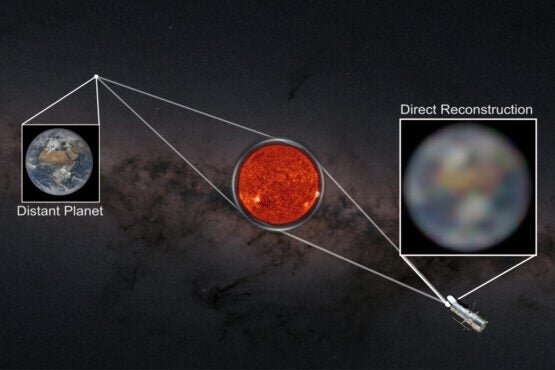Scientists describe a gravity telescope that could image exoplanets.
Astronomers have discovered more than 5,000 planets orbiting other stars since the first exoplanet was discovered in 1992. When astronomers discover a new exoplanet, however, we only learn a few details about it: its existence and a few characteristics, but the rest remains a mystery.
Stanford University astrophysicists have been working on a new conceptual imaging technique that would be 1,000 times more precise than the strongest imaging technology now in use to get beyond observatories’ physical constraints. Scientists might theoretically manage the warping effect of gravity on space-time, known as lensing, to develop imagery far more complex than any currently available.
The researchers outline a method for using solar gravitational lensing to detect planets outside our solar system in a report published in The Astrophysical Journal on May 2. Scientists might use the sun’s gravitational pull to magnify light from an exoplanet passing by, by aligning a telescope, the sun, and the exoplanet in a line with the sun in the middle. A gravitational lens, unlike a magnifying glass, has a curved space-time that allows it to image faraway objects.
“We want to take pictures of planets that are orbiting other stars that are as good as the pictures we can make of planets in our own solar system,” said Bruce Macintosh, a physics professor at in the School of Humanities and Sciences at Stanford and deputy director of the Kavli Institute for Particle Astrophysics and Cosmology (KIPAC). “With this technology, we hope to take a picture of a planet 100 light-years away that has the same impact as Apollo 8’s picture of Earth.”
The catch, at present, is that their proposed technique would require more advanced space travel than is currently available. Still, the promise of this concept and what it could reveal about other planets, makes it worth continued consideration and development, said the researchers.
The perks of light bending
Gravitational lensing wasn’t experimentally observed until 1919 during a solar eclipse. With the moon obstructing the light from the sun, scientists were able to see stars near the sun offset from their known positions. This was unequivocal proof that gravity could bend light and the first observational evidence that Einstein’s theory of relativity was correct. Later, in 1979, Von Eshleman, a Stanford professor, published a detailed account of how astronomers and spacecraft could exploit the solar gravitational lens. (Meanwhile, astronomers including many at Stanford’s KIPAC now routinely use the powerful gravity of the most massive galaxies to study the early evolution of the universe.)
However, the imaging technology was not fully studied in order to see planets until 2020. Slava Turyshev of the California Institute of Technology’s Jet Propulsion Laboratory presented a way in which a space-based telescope might utilize rockets to sweep around the beams of light from a planet to reconstruct a crisp image, but the process would take a long time and a lot of fuel.
Building on Turyshev’s work, KIPAC Ph.D. student Alexander Madurowicz devised a new approach for reconstructing a planet’s surface from a single snapshot taken directly at the sun. By collecting the exoplanet’s ring of light around the sun, Madurowicz’s program may undistort the light by reversing the bending caused by the gravitational lens, turning the ring back into a round planet.
Madurowicz used photographs of the rotating Earth collected by the DSCOVR spacecraft, which sits between Earth and the sun, to explain his work. Then he created a computer model to explore how Earth would seem through the warping effects of gravity from the sun. Madurowicz was able to retrieve the photos of Earth and establish that his calculations were right by applying his technique to the data.
In order to capture an exoplanet image through the solar gravitational lens, a telescope would have to be placed at least 14 times farther away from the sun than Pluto, past the edge of our solar system, and further than humans have ever sent a spacecraft. But, the distance is a tiny fraction of the light-years between the sun and an exoplanet.
“By unbending the light bent by the sun, an image can be created far beyond that of an ordinary telescope,” Madurowicz said. “So, the scientific potential is an untapped mystery because it’s opening this new observing capability that doesn’t yet exist.”
Beyond the solar system
Currently, we would require a telescope 20 times the size of the Earth to image an exoplanet with the resolution described by the scientists. Scientists can use the sun’s gravity as a telescope to create a giant natural lens. A Hubble-sized telescope combined with the solar gravitational lens would be enough to scan exoplanets with sufficient resolution to catch fine surface details.
“The solar gravitational lens opens up an entirely new window for observation,” said Madurowicz. “This will allow investigation of the detailed dynamics of the planet atmospheres, as well as the distributions of clouds and surface features, which we have no way to investigate now.”
Both Madurowicz and Macintosh estimate that it will take at least 50 years, if not more, for this technology to be deployed. We will need quicker spacecraft to implement this because, with current technology, traveling to the lens could take 100 years. The time could be as little as 20 or 40 years if solar sails or the sun are used as a gravitational slingshot. Despite the unclear timescale, the idea of discovering whether some exoplanets have continents or oceans motivates them, according to Macintosh. The presence of either is a strong indicator that life exists on another planet.
“This is one of the last steps in discovering whether there’s life on other planets,” Macintosh said. “By taking a picture of another planet, you could look at it and possibly see green swatches that are forests and blue blotches that are oceans—with that, it would be hard to argue that it doesn’t have life.”
Source Phys.org and Stanford University

